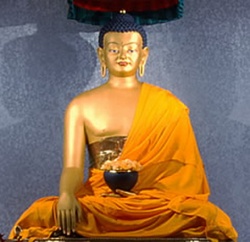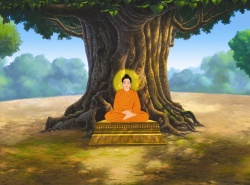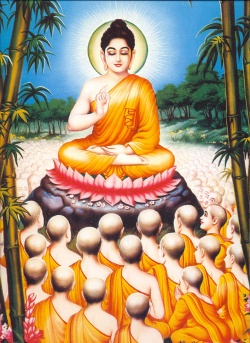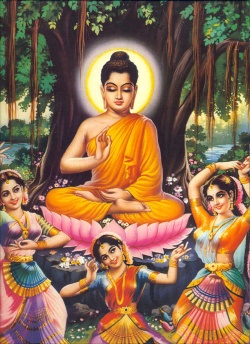Taṇhā
Taṇhā (Pāli; Sanskrit: tṛṣṇā, also trishna) literally means "thirst," and is commonly translated as craving or desire. Taṇhā is defined as the craving or desire to hold onto pleasurable experiences, to be separated from painful or unpleasant experiences, and for neutral experiences or feelings not to decline. In the first teaching of The Buddha on the Four Noble Truths, The Buddha identified taṇhā as a principal cause in the arising of Dukkha (Suffering, anxiety, dissatisfaction). Taṇhā is also identified as the eighth link in the Twelve Links of Dependent origination.
Overview
Taṇhā is the craving or desire to hold onto pleasurable experiences, to be separated from painful or unpleasant experiences, and for neutral experiences or feelings not to decline.
In the first teaching of The Buddha on the Four Noble Truths, The Buddha identified taṇhā as a principal cause in the arising of Dukkha (Suffering, anxiety, dissatisfaction). Walpola Rahula states:
- It is this "thirst", desire, greed, craving, manifesting itself in various ways, that gives rise to all forms of Suffering and the continuity of beings. But it should not be taken as the first cause, for there is no first cause possible as, according to Buddhism, everything is relative and inter-dependent. Even this "thirst", taṇhā, which is considered as the cause or origin of Dukkha, depends for its arising (samudaya) on something else, which is sensation (vedanā), and sensation arises depending on contact (Phassa), and so on and so forth goes on the circle which is known as Conditioned Genesis (Paṭicca-samuppāda)... So taṇhā, "thirst", is not the first or the only cause of the arising of Dukkha. But it is the most palpable and immediate cause, the "principal thing" and the "all-pervading thing". Hence in certain places of the original Pali texts themselves the definition of samudaya or the origin of Dukkha includes other defilements and impurities (kilesā, sāsavā dhammā), in addition to taṇhā "thirst" which is always given the first place. Within the necessarily limited space of our discussion, it will be sufficient if we remember that this "thirst" has as its centre the false idea of self arising out of ignorance.
Taṇhā is also identified as the eight link in the Twelve Links of Dependent origination. In the context of the twelve links, the emphasis is on the types of craving "that nourish the karmic potency that will produce the next lifetime."
Taṇhā is a type of desire that can never by satisfied. Ajahn Sucitto states:
- However, taṇnhā, meaning "thirst," is not a chosen kind of desire, it's a reflex. It's the desire to pull something in and feed on it, the desire that's never satisfied because it just shifts from one Sense base to another, from one emotional need to the next, from one sense of achievement to another goal. It's the desire that comes from a black hole of need, however small and manageable that need is. The Buddha said that regardless of its specific topics, this thirst relates to three channels: sense-craving (kāmataṇhā); craving to be something, to unite with an experience (bhavataṇhā); and craving to be nothing, or to dissociate from an experience (vibhavataṇhā).
Types
The Buddha identified three types of craving (taṇhā): sense-craving, craving to be, craving not to be.
Sense-craving
- Pali: kāma-taṇhā
- Also referred to as craving for "sensuality" or "sensual pleasures"
- This is a craving for sense objects which provide pleasant feeling, or craving for sensory pleasures.
- Walpola Rahula states that Tanha includes not only desire for sense-pleasures, wealth and Power, but also "desire for, and attachment to, ideas and ideals, views, opinions, theories, conceptions and beliefs (Dhamma-taṇhā)."
Craving to be
- Pali: Bhava-taṇhā
- Also referred to as craving for "becoming" or "existence"
- This is craving to be something, to unite with an experience.
- Ron Leifer states: "The desire for life is present in the body at birth, in its homeostatic, hormonal, and reflexive mechanisms... At the more subtle level of ego, the desire for life is the ego's striving to establish itself, to solidify itself, to gain a secure foothold, to prevail and dominate, and so to enjoy the sensuous delights of the phenomenal world. The desire for life manifests itself in all of ego's selfish, ambitious strivings..."
- Ajahn Sucitto states: "Craving to be something is not a decision, it’s a reflex... So the result of craving to be solid and ongoing, to be a being that has a past and a future, together with the current wish to resolve the past and future, are combined to establish each individual’s present world as complex and unsteady. This thirst to be something keeps us reaching out for what isn’t here. And so we lose the inner balance that allows us to discern a here-and-now fulfillment in ourselves."
Craving not to be
- Pali: vibhava-taṇhā
- Also referred to as craving for "no becoming" or "non-existence" or "extermination"
- This is craving to not experience the world, and to be nothing.
- The Dalai Lama states that craving for "destruction is a wish to be separated from painful feelings".
- Ron Leifer states: "As the desire for life is based on the desire for pleasure and happiness, the desire for death is based on the desire to escape pain and (suffering)... The desire for death is the yearning for relief from pain, from anxiety, from disappointment, despair, and negativity."
- "The motive for the desire for death is most transparent in cases of suicide. Clearly, people with terminal illnesses who commit suicide are motivated by the desire to escape from physical pain and Suffering. In so-called "altruistic" suicide, such as hari-kari, kamakazi, and other forms of socially conditioned suicide, the motive is to avoid mental Suffering–shame, humiliation, and disgrace."
Comparison to Chanda
The Buddhist teachings contrast the reflexive, self-centered desire of taṇhā with the wholesome type of desire for well-being, called Chanda.
Ajahn Sucitto states:
- Sometimes taṇhā is translated as “desire,” but that gives rise to some crucial misinterpretations with reference to the way of Liberation. As we shall see, some form of desire is essential in order to aspire to, and persist in, cultivating the path out of Dukkha. Desire as an eagerness to offer, to commit, to apply oneself to meditation, is called Chanda. It’s a psychological “yes,” a choice, not a pathology. In fact, you could summarize Dhamma training as the transformation of taṇhā into Chanda. It’s a process whereby we guide volition, grab and hold on to the steering wheel, and travel with clarity toward our deeper well-being. So we’re not trying to get rid of desire (which would take another kind of desire, wouldn’t it). Instead, we are trying to transmute it, take it out of the shadow of gratification and need, and use its aspiration and vigor to bring us into light and clarity.
Effects
Taṇhā is said to be a principal cause of Suffering in the world. Walpola Rahula states:
- According to The Buddha’s analysis, all the troubles and strife in the world, from little personal quarrels in families to great wars between nations and countries, arise out of this selfish ‘thirst’. From this point of view, all economic, political and social problems are rooted in this selfish ‘thirst’. Great statesmen who try to settle international disputes and talk of war and peace only in economic and political terms touch the superficialities, and never go deep into the real root of the problem. As The Buddha told Raṭṭapāla: “The world lacks and hankers, and is enslaved to “thirst” (taṇhādāso).
In the Maha-Nidana Sutta (The Great Causes Discourse), Buddha said:
- Now, craving is dependent on feeling, seeking is dependent on craving, acquisition is dependent on seeking, ascertainment is dependent on acquisition, desire and passion is dependent on ascertainment, attachment is dependent on desire and passion, possessiveness is dependent on attachment, stinginess is dependent on possessiveness, defensiveness is dependent on stinginess, and because of defensiveness, dependent on defensiveness, various evil, unskillful phenomena come into play: the taking up of sticks and knives; conflicts, quarrels, and disputes; accusations, divisive speech, and lies.
Qualities
Non-deliberate
Contemporary Buddhist teacher Chogyam Trungpa emphasizes the non-deliberate quality of Tanha. He states:
- (Craving) is like someone who is extremely hungry. Such a person doesn't actually think in terms of eating the food, chewing it and swallowing it. Instead the food just goes into his stomach. It's very simple, there's no effort involved, it just goes into him... Craving in this case is not so much what the weightwatcher's club talks about, but it's genuine craving. It actually just happens. We could actually say to somebody literally, "I don't know what happened, I just did it. It just happened to me. It just happens to me constantly." ... So it's instant craving, rather than deliberate craving as such. At that level, there's no intellectualization at all involved.
Bipolar
Taṇhā encompasses both the desire to get something and its opposite, the desire to get rid of it.
Ron Leifer states:
- ...taṇhā itself is bipolar, divided into greed and hatred, or passion and aggression. On the one hand is the desire to have something, to possess it, to experience it, to pull it in, to own it. On the other hand is the desire to avoid something, to keep it away, reject it, renounce it, destroy it, and separate it from oneself. If we call these two poles desire and aversion, we can see more clearly that they represent the antithetical poles of taṇhā–the desire to possess and the desire to get rid of.
Unsatisfactory, unquenchable, addictive
Taṇhā is represented in the bhavacakra by a group of people drinking beer or partying. The more they drink, the more their craving keeps growing.
Ron Leifer states:
- Desire [i.e. taṇhā) causes Suffering by its own nature because it is inherently unsatisfactory. Desire means deprivation. To want something is to lack it, to be deprived of it. We do not want things we have, we only want things we don't have. Thirst is the desire for water and it occurs in the absence of water. Hunger is the feeling of lacking food. Desiring means not having, being frustrated, Suffering. Craving is Suffering. This is a most important insight, one which we drive into secrecy by our refusal to acknowledge it, thus creating the esoteric knowledge we then seek.
Most people tend to act under the assumption that if one's desires are fulfilled it will, of itself, lead to lasting happiness or well-being. However, the Buddhist teachings state that desire for conditioned things cannot be fully satiated or satisfied, due to their impermanent nature. This is expounded in the Buddhist teaching of impermanence.
Relation to the Three poisons
Taṇhā and Avidya (ignorance) can be related to the Three poisons as follows:
- Avidya (ignorance), the root of the Three poisons, is also the basis for taṇhā.
- Raga (attachment), the second of the Three poisons, is equivalent to Bhava-taṇhā (craving to be) and kāma-taṇhā (sense-craving).
- Dvesha (aversion), the third of the Three poisons, is equivalent to vibhava-taṇhā (craving not to be).
Relation to addiction
Taṇhā is sometimes related to the Western psychological concept of addiction. For example:
The Dalai Lama states:
- Much human Suffering stems from destructive emotions, as hatred breeds violence or craving fuels addiction. One of our most basic responsibilities as caring people is to alleviate the human costs of such out-of-control emotions.
Ron Leifer states:
- Obsessions, compulsions, and addictions are desires out of control, desires gone wild.
Mingyur Rinpoche states:
- Attachment is in many ways comparable to addiction, a compulsive dependency on external objects or experiences to manufacture an illusion of wholeness. Unfortunately, like other addictions, attachment becomes more intense over time.
Cessation
The third noble truth teaches that the cessation of taṇhā is possible.
- Bhikkhus, there is a noble truth about the cessation of Suffering. It is the complete fading away and cessation of this craving; its abandonment and relinquishment; getting free from and being independent of it.”
Cessation is possible by following the Noble Eightfold Path. Within this path, contemplating the impermanent nature of all things is regarded as a specific antidote to taṇhā.
Mara's daughter
Taṇhā is sometimes identified as one of Māra's three daughters, along with Arati (Boredom), and Rāga (Passion). In some accounts of The Buddha's Enlightenment, it is said that the demon Māra sent his three daughters to tempt The Buddha to give up his quest.
In a similar fashion, in Sn 436 (Saddhatissa, 1998, p. 48), taṇhā is personified as one of Death's four armies (senā) along with desire (kāmā), aversion (arati) and hunger-thirst (khuppipāsā).
Etymology
The literal meaning of taṇhā is "thirst"; however, in Buddhism it has a technical meaning described above. In part due to the variety of possible translations, taṇhā is sometimes used as an untranslated technical term by authors writing about Buddhism. One source suggests that the opposite of taṇhā is Upekkha (peace of mind, equanimity).
Smith and Novak emphasize the difficulty of translating this term; they state:
- The cause of life’s dislocation is Tanha. Again, imprecisions of translations—all are to some degree inaccurate—make it wise to stay close to the original word. Tanha is usually translated as “desire.” There is some truth in this, but if we try to make “desire” Tanha’s equivalent, we run into difficulties. To begin with, the equivalence would make this Second Truth unhelpful, for to shut down desires, all desires, in our present state would be to die, and to die is not to solve life’s problem. But beyond being unhelpful, the claim of equivalence would be flatly wrong, for there are some desires The Buddha explicitly advocated—the desire for liberation, for example, or for the happiness of others.





